I'd been invited to the Irlam Station Launch that day by Hamilton Davies Trust and the joining instructions gave details of car parking arrangements adding "But wouldn't it be great to arrive at the station launch by train?". I replied (somewhat indignantly) "CAR? No, I intended to entrust myself to the tender mercies of Northern Rail in any case." Northern Rail had kindly provided some complimentary tickets from Manchester or Liverpool to Irlam and one of these was issued to me.
The simplest route would probably have been Wolverhampton to Warrington Bank Quay, walk to Warrington Central then two stops along the former Cheshire Lines Committee route to Irlam. However, to give me the opportunity of further research on Edge Hill Cutting, I decided to travel on the 11:20 'London Midland' service from Wolverhampton to Liverpool Lime Street and then on the 12:55 'Northern Rail' service as far as Irlam.
The Wolverhampton to Stafford line is in the process of being re-signalled, prior to control being transferred to the West Midlands Signalling Centre. Network Rail are committed to centralising signalling control at a small number of Integrated Electronic Control Centres (IECC) covering large areas. There's a brief description in 'Wikipedia' here. The picture below (snatched from a passing train on an earlier journey on the Derby Line) shows the West Midlands Signalling Centre at Saltley, Birmingham, which is progressively taking over control of the the railways in the West Midlands.
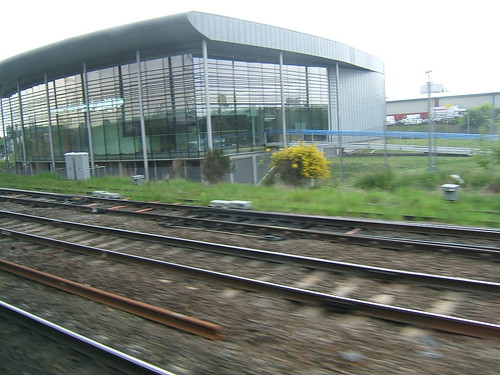 The futuristic West Midlands Signalling Centre at Saltley, Birmingham.
The futuristic West Midlands Signalling Centre at Saltley, Birmingham.
On the way to Stafford, we passed a number of small gangs of men working on signalling . Some replacement signals were already in use, others were lying flat, awaiting installation. At present, the next signal box to Wolverhampton Power Signal Box is Stafford Number 4, south of Stafford station and then Stafford Number 5, north of Stafford station. We made our scheduled stop at Stafford and then made good time on the Down Fast to Crewe. The signalling on the line from Stafford to Crewe was modernised some years ago and is now controlled from Stoke-on-Trent. However, approaching Crewe, control passes first to Basford Hall Junction (a much-modernised LNWR box) and then to Crewe Signalling Centre which is situated on the site of the former Crewe North Motive Power Depot (and which I always think looks like a B & Q warehouse). We arrived in platform 11, where quite a few passengers got off or boarded. I didn't find out the significance of the 'bear' wearing a High Visibility jacket who was trying to embarrass the member of station staff 'seeing us away'.
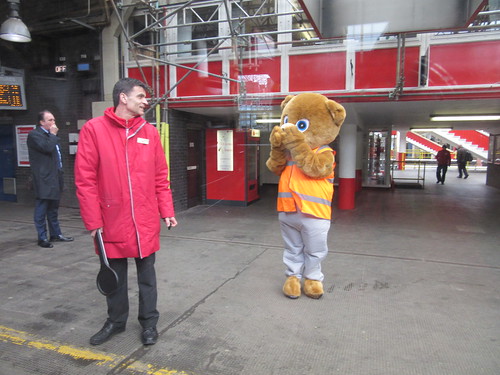 The 'bear' in the High Visibility jacket at Crewe station.
The 'bear' in the High Visibility jacket at Crewe station.
Crewe Signalling Centre only controls the immediate station area (it was a 'temporary' arrangement, some years ago) so the next signal box is the A.R.P. box at Crewe Coal Yard. From Crewe, we ran on the Down Slow, so I was not surprised when we slowed to a standstill just short of Winsford where the four running lines (Down Slow, Down Fast, Up Fast, Up Slow) reduced to two. I correctly guessed that we were about to be overtaken. Sure enough, I noticed the overhead line over the Down Fast start to oscillate slowly up and down and a few seconds later a 'Pendolino' swept by us. The pressure wave caused my train to lean away briefly on its air suspension. The overhead line over the Down Fast continued to oscillate after the train had passed. Very soon, our signal cleared and we carried on to our booked stop at Winsford station. The next box to Crewe Coal Yard is Winsford (another much-modernised LNWR box) which controls the line to and including Weaver Junction, interfacing with Halton Junction (on the Liverpool Line) and Warrington Power Signal Box (on the West Coast Main Line). We made further booked stops at Hartford and Acton Bridge before taking the Liverpool line at Weaver Junction. The previous signal box at Weaver Junction still stands on the up side with its operating floor boarded-up. It had a small 'NX' panel put in when the West Coast Main Line was first electrified.
Next, on our left, Halton Junction signal box is another LNWR survivor, heavily modified. The former double track spur to Frodsham has been singled and made uni-directional, allowing traffic from Frodsham to Halton Junction but not the other way. We then passed through the sandstone cutting to Runcorn station, which retains its A.R.P. signal box. After a brief stop at the character-less modern station, we crossed the River Mersey on the spans of the lattice-girder Runcorn Railway Bridge (with its Grade II* listing) and then traversed the sweeping Ditton Viaduct.
The station at Ditton Junction is long closed but one LNWR signal box hangs on, called simply 'Ditton'. There are four running lines (paired by use) from here to Wavertree. There are Exchange sidings on our left serving the car plant at Halewood then another surviving LNWR signal box, Speke Junction, controlling one junction of the triangular connection serving the Freightliner depot adjacent to Garston Dock. Freightliner call this Depot 'Liverpool', to distinguish it from their 'Seaforth' depot. There's an outline of their Port and Terminal Network here. The second junction to Garston is controlled by the next signal box - Allerton Junction, which also controls the junction with the Hunt's Cross Chord which allows trains from Lime Street to join the former Cheshire Lines Committe route to Manchester. We stopped at the modern station of Liverpool South Parkway (formerly Allerton) so I could have changed here for the Northern Rail service to Irlam but, as I mentioned above, I'd decided to use the trip to look again at the Lime Street Cutting. My train carried on to Edge Hill (where there's an 'NX' signal box) then down through the cutting to Lime Street, still controlled by a Westinghouse Style 'L' 'All Electric' power frame in the A.R.P. design signal box dating from the 1940s.
I knew that video from inside a train with no opening windows, double-glazing and bright lights wouldn't be very good, but there's a video from Edge Hill to Lime Street here.
My train arrived at its usual platform 8, leaving me plenty of time to make my way across to the 'local' platforms (1 to 6). The original Liverpool and Manchester Line had been recently electrified at 25 kV a.c. and I was able to get a picture of one of the "new" Northern Rail electric multiple units. Four-car set 319 363 was standing in platform 1 looking quite smart in its blue livery labelled 'Northern Electrics'. Of course, the Class 319 were introduced between 1987 and 1990 and have seen heavy use in the London area. There's a Wikipedia article here. Early in 2015, the first of 20 sets of the 25-year old trains cascaded from the London area entered service following 'overhaul'. Northern Rail wax quite lyrical about the new seats and paint job here. Of course, under our crazy rail privatisation, trains are actually owned by one of the 'ROSCOs' - Rolling Stock Companies, in this case Porterbrook and their sales catalogue for Class 319 here makes interesting reading.
 Class 319 electric at Liverpool Lime Street.
Class 319 electric at Liverpool Lime Street.
The big departure board on the concourse gave platform 6 for the 'Northern Rail' train to Manchester Oxford Road I was to catch. I was 'foxed' for a minute because the Passenger Information Display at the entrance to the platform only showed a Norwich service. Then, I realised that the 2-coach Class 156 on the buffer stops was my train and the other coaches formed the East Midlands Trains service to Norwich. We set off on the same route as the Norwich train, but we were booked to stop at most stations. Up the bank on the Up Fast to a brief stop at Edge Hill station, then we passed Edge Hill Power Signal Box and diverged to the right onto the Crewe line stopping at Mossley Hill, West Allerton and Liverpool South Parkway. Allerton Junction signal box turned us onto the Hunt's Cross Chord. As we passed Northern Rail's Allerton Train Maintenance Depot, I spotted another of the "new" electrics.
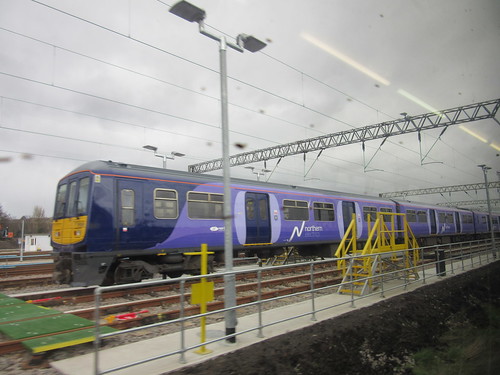 Class 319 electric at Allerton Train Maintenance Depot.
Class 319 electric at Allerton Train Maintenance Depot.
Our next stop was Hunts Cross where most of the people on the platform were waiting for the Merseyrail electric train (there's a brief description of an earlier visit to Hunts Cross in More Merseyrail. Setting off again, we passed the rather bleak modern signal box then stopping at Halewood, Hough Green and Widnes. As I mentioned in the the section 'THE CLC ROUTES TODAY' forming part of the post The Cheshire Lines Committee, 'Widnes' station was orignally named Farnworth but when the loop through Widnes was abandoned and the original Widnes station lost, the name was transferred to Farnworth. I doubt if many people were fooled by this sleight-of-hand. Then we stopped at Sankey for Penketh and Warrington Central. At platform level, this station, with its polychromatic brickwork and glazed canopies supported on cast columns has been quite attractively restored. The structure of the classical main station building on the up side survives (let out to small businesses, I believe) but access from the street is now via the usual miserable British Railways 'modern' building. Warrington Central retains its British Rail Standard signal box on the down side. My train was not booked to stop at the next station, Padgate and after pausing at Birchwood (modern brick brutalism, I'm afraid) we didn't stop at Glazebrook either, but other services do stop at both Padgate and Glazebrook. The triangular connection to the G.C.R. line to Wigan west of Glazebrook station is long gone, together with the signal boxes at Dam Lane Junction and Glazebrook West Junction but I did spot a redundant road overbridge over the former branch from Glazebrook West Junction. Glazebrook East Junction (another British Rail Standard signal box) survives, although the branch to Stockport and the Exchange Sidings with the Manchester Ship Canal have gone. The box now talks to Warrington Central signal box and Manchester Piccadilly Signalling Centre and controls a Down Passenger Loop and a crossover between the main lines. The next stop was Irlam where I left the train and I received my first sight of the Irlam station building I'd come to visit. My train departed, to shortly cross over the Manchester Ship Canal.
When the Cheshire Lines Committee built the line from Liverpool Central to Manchester, they placed the main station building at each intermediate station, including Irlam, on the Down side of the track. Later, when the Manchester Ship Canal was built, it intersected the railway just east of Irlam station. So that a bridge could be used to carry the railway over the canal, inclines were necessary in the railway on either side of the bridge and the railway was deviated to the south. This required a new station to be built to the west of the first station. After the deviation and new station were introduced, Irlam became the only intermediate station on the line where the main station building was on the Up side of the line!
 Irlam Station: The train which had brought me from Liverpool about to leave.
Irlam Station: The train which had brought me from Liverpool about to leave.
For a description of the 'launch' itself, see Irlam Station Launch.
SIGNALLING FROM WOLVERHAMPTON TO LIVERPOOL
Wolverhampton Power Signal Box in 2013

Click here for other sizes.
Stafford No. 4 in 2013
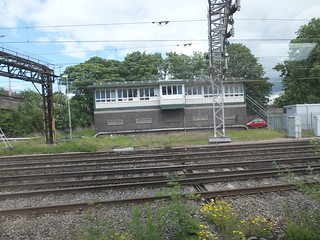
Click here for other sizes.
Stafford No. 5 in 2013

Click here for other sizes.
Stoke-on-Trent Signal Control Centre
Sorry, no suitable illustration at present.
Basford Hall Junction in 2013

Oh dear - not very good.
Crewe Signal Control Centre in 2014

Click here for other sizes.
Crewe Coal Yard in 2015
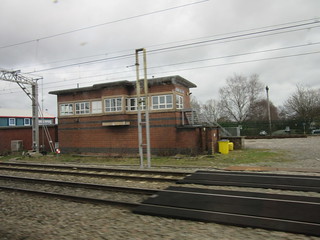
Click here for other sizes.
Winsford in 2015
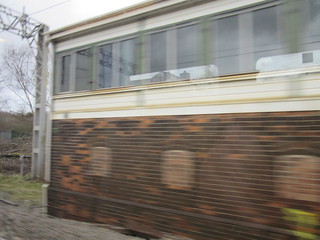
Click here for other sizes.
Halton Junction
Sorry, no suitable illustration at present. I found a picture of the box on sale here.
Runcorn in 2010
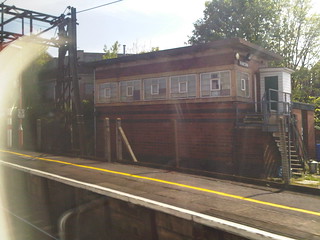
Click here for other sizes.
Ditton
Sorry, no suitable illustration at present.
Speke Junction, 2012
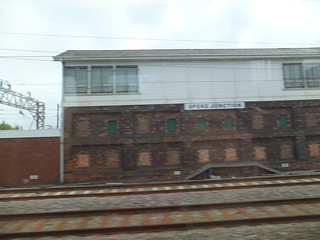
Click here for other sizes.
Allerton Junction in 2015

Click here for other sizes.
Edge Hill Power Signal Box in 2010

Click here for other sizes.
Liverpool Lime Street Power Signal Box in 2012
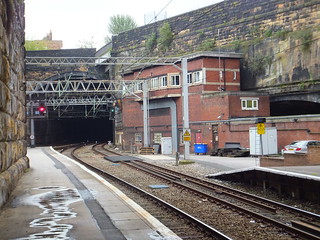
Click here for other sizes.
Related articles on other sites
Stations and Junctions (around Irlam).
The Industries of Irlam and Cadishead.
Related posts on my site
Day Trip to Liverpool (2010: Brief).
Liverpool by Train (2012).
Liverpool Lime Street.
The Cheshire Lines Committee.
The Cheshire Lines Committee Routes Today.
Signalling on the former Cheshire Lines Committee in the 1950s
Irlam Station Launch.
My pictures
West Midland Railways.
Stafford Area rail.
Crewe Area rail.
Liverpool area rail.
CLC Manchester - Liverpool.
Irlam Station Launch.
